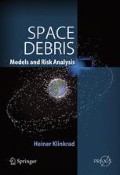Abstract
In previous chapters all collision flux estimates and corresponding collision probabilities were purely based on stochastic methods which did not consider the estimated orbital positions of objects. While orbits of the whole debris population were propagated across the historic evolution of the environment, the coarse first-order prediction methods were only used to derive time histories of spatial object densities and transient velocities in a gridded 3D control volume. Such statistical assessments are justified for small debris objects which were generated by stochastic release models into orbits with poorly known initial conditions. For larger-size objects, however, USSTRATCOM is maintaining a catalog of tracked objects (see Chapter 2), with routinely updated orbit information in a so-called Two-Line Element (TLE) format. When used with care, such data can be employed to improve the safety of operational spacecraft by means of a conjunction prediction and collision warning service for missions in densely populated orbital regions.
Access this chapter
Tax calculation will be finalised at checkout
Purchases are for personal use only
Preview
Unable to display preview. Download preview PDF.
8.6 References
Alarcón, J. (2002). Development of a Collision Risk Assessment Tool. Technical Report (final report) ESA contract 14801/00/D/HK, GMV S.A.
Alby, F., Lansard, E., and Michal, T. (1997). Collision of Cerise with Space Debris. In Proceedings of the Second European Conference on Space Debris, ESA SP-393, pages 589–596.
Alfriend, K., Akella, M., Lee, D., Frisbee, J., and Foster, J. (1999). Probability of Collision Error Analysis. Space Debris, vol.1, no.1:21–35.
anon. (2005). Accidential Collisions of Cataloged Satellites Identified. The Orbital Debris Quarterly News, 9, Issue 2:1–2.
Bendisch, J., Bunte, K., Sdunnus, H., Wegener, P., Walker, R., and Wiedemann, C. (2002). Upgrade of ESA’s MASTER Model. Technical Report (final report) ESA contract 14710/00/D/HK, ILR/TUBS, Braunschweig.
Bérend, N. (1997). Étude de la Probabilité de Collision Entre un Satellite et des Débris Spatiaux. Technical Report no. RT 38/3605 SY, ONERA.
Foster, J. (1992). A Parametric Analysis of Orbital Debris Collision Probability and Maneuver Rate for Space Vehicles. Technical Report NASA JSC-25898, NASA.
Foster, J. (2001a). International Space Station Debris Avoidance Operations. The Orbital Debris Quarterly News, 6, Issue 2.
Foster, J. (2001b). The Analytical Basis for Debris Avoidance Operations of the International Space Station. In Proceedings of the Third European Conference on Space Debris, ESA SP-473, pages 441–445.
Hoots, F., Crawford, L., and Roehrich, R. (1984). An Analytical Method to Determine Future Close Approaches Between Satellites. Celestial Mechanics, vol.33.
Hoots, F. and Roehrich, R. (1980). Spacetrack Report No.3 — Models for the Propagation of NORAD Element Sets. Technical report, Office of Astrodynamics, Aerospace Defense Center, Peterson AFB, CO.
Khutorovsky, Z., Boikov, V., and Kamensky, S. (1993). Direct Method for the Analysis of Collision Probability of Artificial Space Objects in LEO — Techniques, Results, and Applications. In Proceedings of the First European Conference on Space Debris, ESA SD-01, pages 491–508.
Klinkrad, H. (1997). One Year of Conjunction Events of ERS-1 and ERS-2 with Objects of the USSPACECOM Catalog. In Proceedings of the Second European Conference on Space Debris, ESA SP-393, pages 601–611.
Matney, N., Anz-Meador, P., and Foster, J. (2002). Covariance Correlations in Collision Avoidance Probability Calculations. COSPAR Congress, PEDAS1-B1.4-0038-02.
Montenbruck, O. and Gill, E. (2000). Satellite Orbits — Models, Methods, and Applications. Springer, Berlin, Heidelberg, New York.
Patera, R. (2001). General Method for Calculating Satellite Collision Probability. Journal of Guidance, Control & Dynamics, vol.24:716–722.
Sánchez-Ortiz, N., Belló-Mora, M., and Klinkrad, H. (2004). Collision Avoidance Maneuvers During Spacecraft Lifetime — Analysis of Operational Missions. 55th IAC Congress, IAC-04-IAA.5.12.5.10.
Rights and permissions
Copyright information
© 2006 Praxis Publishing Ltd, Chichester, UK
About this chapter
Cite this chapter
Klinkrad, H., Alarcón, J., Sánchez, N. (2006). Operational Collision Avoidance with Regard to Catalog Objects. In: Space Debris. Springer Praxis Books. Springer, Berlin, Heidelberg . https://doi.org/10.1007/3-540-37674-7_8
Download citation
DOI: https://doi.org/10.1007/3-540-37674-7_8
Publisher Name: Springer, Berlin, Heidelberg
Print ISBN: 978-3-540-25448-5
Online ISBN: 978-3-540-37674-3
eBook Packages: EngineeringEngineering (R0)

